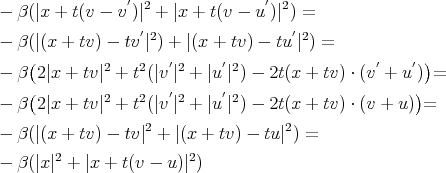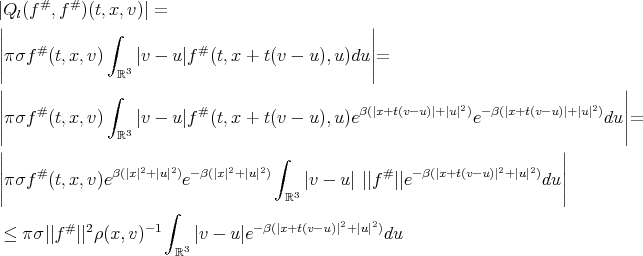Servicios Personalizados
Revista
Articulo
Indicadores
-
 Citado por SciELO
Citado por SciELO
Links relacionados
-
 Similares en
SciELO
Similares en
SciELO
Compartir
Revista de la Unión Matemática Argentina
versión impresa ISSN 0041-6932versión On-line ISSN 1669-9637
Rev. Unión Mat. Argent. v.48 n.1 Bahía Blanca ene./jun. 2007
The Boltzmann equation with Force Term near the Vacuum
Rafael Galeano Andrades
Abstract. We prove a theorem of existence, uniqueness and positivity of the solution for the Boltzmann equation with force term and initial data near the Vacuum.
Key words and phrases. Force Term, Boltzmann equation, Near the vacuum
This article is a result of the project of investigation ”Evolution of Equations of Kinetic Type”, financed by the University of Cartagena.
The aim in this article it is prove global existence of the problem for small data (near to the vacuum) in the case of a solid sphere. For the density  ,we write the equation of Boltzmann:
,we write the equation of Boltzmann:
 | (1) |
Let us also consider the following problem:
 | (2) |
where

here  ,
,  is a constant proportional to the area of the sphere and
is a constant proportional to the area of the sphere and
 |
 .
.
The Conservation momentum is given by

and the Energy of conservation is

We write  , where
, where

Let  be a vectorial field not depending on f such that:
be a vectorial field not depending on f such that:

and for a given  , let
, let

with norm

This makes  into a Banach Space [8].
into a Banach Space [8].
To solve problem (2) we introduce the following notation:
 | (3) |
with F differentiable with regard to time. Therefore

we write the equation (1) as
 | (4) |
Integrating (3) with respect to time, we obtain
 | (5) |
We observe that if F is constant in time, (2) reduces to (1). We will prove the following theorems:
Theorem 1. There exists a constant  , such that if
, such that if  and
and  are sufficiently small and
are sufficiently small and  is differentiable with regard to the time
is differentiable with regard to the time  , then the equation (4) has a unique solution
, then the equation (4) has a unique solution  .
.
 | (6) |
There are constants  and
and  such that if
such that if  and
and  are sufficiently small, then the equation (5) has a unique non-negative solution
are sufficiently small, then the equation (5) has a unique non-negative solution  .
.
To solve problem (1) we consider:
 | (7) |
Assuming F integrable with regard to the time and therefore
 | (8) |
and integrating we obtain again (5) and the theorems are completed, but with F integrable with regard to the time.
This topic is developed in [4], as well as in the articles [11], [9], [5] and [15].
Article [11] refers to a gas with a strong sphere and to a initial condition which tends exponentially to zero at infinity in phase space. Article [9] generalizes results of [11] to the Boltzmann equation with interaction potential between two particles. In both articles, the mass of the gas is infinite. In another direction the result of [5] refers to a gas with infinite mass where the initial condition is assumed to decay in a physical space with behavior of power inverse. In this case for sufficiently small decay the mass of the gas can be infinite. Another generalization is given in the article [15] where global existence is proven for initial conditions decaying with behavior of power inverse in the whole phase space. The articles [5] and [13] refer both to Boltzmann equation with interaction of general potential for the couples of internal forces of particles. Besides these previously mentioned articles, we also have to mention two results given by Polewczak. In the first one [13], the author generalizes the theory of previously limited existence to the case of mild solution, also to the case of classic solution. In the second [14] the mathematical results are generalized to the case of initial conditions with more general decay at infinity in phase space.
On the Problem of Cauchy with field of External force
First, let us consider the spatially inhomogeneous equation for neuter particles in a force field  . In relationship with this topic we should mention the article of Asano [1] in which local existence is proven for general initial conditions. The formulation of Asano is the starting point of all the studies developed in this article.
. In relationship with this topic we should mention the article of Asano [1] in which local existence is proven for general initial conditions. The formulation of Asano is the starting point of all the studies developed in this article.
Some studies of the problem can be seen in the articles [2], [7], [10] and [6]. In particular, the articles of Asano [2] and Grunfeld [7] provide a global existence proof for the solution with initial condition close to equilibrium and a conservative force field. Hamdache [10] gives us a result with initial conditions decaying exponentially to zero at infinity in phase space and trajectories prescribed by a oscillating field. In [6] it is given a result of global existence for decaying conditions and for a force field acting in an interval of time ![[0,T ]](/img/revistas/ruma/v48n1/1a0738x.png) with
with  big, but finite. Recently in [12] Lions developed the problem of Cauchy in
big, but finite. Recently in [12] Lions developed the problem of Cauchy in  in the presence of an external field. The important aspect of the result in [12] is that refers to force fields depending on the distribution function, this case is entirely different from the cases previously prescribed.
in the presence of an external field. The important aspect of the result in [12] is that refers to force fields depending on the distribution function, this case is entirely different from the cases previously prescribed.
This article divides into two parts, the first one has to do with a theorem which, as opposed to the articles previously mentioned, solves the problem for fields differentiable with regard to time, and subsequently we extend it to a theorem of positivity of the solutions.
Demonstration of the theorem 1. Indeed, let us consider :

where
(a)

(b)

now

therefore

(c)

(d)

here  , therefore
, therefore

now  ; [8, pag. 28]
; [8, pag. 28]
This is,

(e) We define the operator  on
on  by
by

and let 
The previous estimates show that if  and
and  , then
, then

We choose  . Therefore
. Therefore  applies
applies  into itself for
into itself for  sufficiently small. Now
sufficiently small. Now  is a contraction on
is a contraction on  . Since the elements of
. Since the elements of  are continuous, by the fixed point theorem the statement is proven. □
are continuous, by the fixed point theorem the statement is proven. □
Demonstration of the theorem 2. If  and
and  are sufficiently small, then
are sufficiently small, then
 | (9) |
and therefore the system
 | (10) |
has a unique global solution  with
with  . Indeed, if
. Indeed, if 

This is , with 

That is, condition (6) is true if

If we define  , we have that
, we have that
 |
and therefore

We write  . This is
. This is
 | (11) |
We want a non negative solution  for (8), and a sufficient condition is:
for (8), and a sufficient condition is:

This is
 | (12) |
To prove the existence of a solution  of (9 ) let us consider the space
of (9 ) let us consider the space

with norm 
Let us consider the operator  defined on
defined on  by:
by:

with  .
.
 applies a sufficiently small ball in
applies a sufficiently small ball in  into itself. Indeed, let
into itself. Indeed, let  , since
, since  ,
,  and
and

This is, for such  ,
,  . Therefore for
. Therefore for 

Namely,  applies non-negative functions in the ball of radius
applies non-negative functions in the ball of radius  into itself, and it is a contraction there if
into itself, and it is a contraction there if  and
and  are sufficiently small.
are sufficiently small.
As  is a contraction,
is a contraction,  , we can take
, we can take  ,
,  and the solution for (9) is non-negative.
and the solution for (9) is non-negative.
It remains to show that  . By definition
. By definition
 |
then

This is  . Now
. Now  ,
,  both are in
both are in  and in this way
and in this way  and
and  are bounded by
are bounded by  ; therefore the conclusion follows if
; therefore the conclusion follows if  is sufficiently small. □
is sufficiently small. □
[1] ASANO K. Local solutions to the initial and initial Boundary value Problem for the Boltzmann equation with and external force. J. Math. Kyoto Univ., 24 (1984), 225-247. [ Links ]
[2] ASANO K. Global Solutions to the initial boundary value Problem for the Boltzmann equation with an external force. Transp. Theory Statist. Phys., 16 (1987), 735-761. [ Links ]
[3] ARLOTTI, BELLOMO N., LACHOWICZ M., POLEWCZAK J., WAHIS Lecture notes on the mathematical theory of the Boltzmann equation. Series on advances in mathematics for applied Sciences, 33 World Scientific (1998). [ Links ]
[4] BELLOMO N., PALCZEWSKI A., TOSCANI G. Mathematical Topics in nonlinear kinetic Theory. World Scientific, (1998). [ Links ]
[5] BELLOMO N. and TOSCANI G.On the Cauchy Problem for the nonlinear Boltzmann equation: Global existence, uniqueness and asymptotic behaviour. J. Math. Phys., 26 (1985) 334-33. [ Links ]
[6] BELLOMO N., LACHOWICZ M., PALCZEWSKI A., TOSCANI G. On the initial value problem for the Boltzmann equation with force term. Transp. Theory Statist. Phys., 18 (1989), 87 - 102. [ Links ]
[7] GRUNFELD C. P.On the Nonlinear Boltzmann equation with force term. Transp. Theory Statist Phys, 14 (1985), 291-322. [ Links ]
[8] GLASSEY ROBERT.The Cauchy Problem in kinetic theory. SIAM [ Links ]
[9] HAMDACHE R.Existence in the Large and Asymptotic behaviour for the Boltzmann equation. Japan J. Appl. Math., 2 (1985),1-15. [ Links ]
[10] HAMDACHE R. Thése, Univ.Pierre et Marie Curie. Paris 1988. [ Links ]
[11] ILLNER R., SHIMBROT M. The Boltzman equation: Global existence for a rare gas in an Infinite Vacuum. Commun. Math. Phys. 95 (1984), 117-126. [ Links ]
[12] LIONS P. L. Compactness in Boltzmann equation via Fourier integrals operator and applications III. J. Math. Kyoto Univ.,34(1994), 539-584. [ Links ]
[13] POLEWCZAK J. Classical solution of the nonolinear Boltzmann equation in all  : asymptotic behaviour of solution. J. Stat. Phys,50 (1988), 611-632. [ Links ]
: asymptotic behaviour of solution. J. Stat. Phys,50 (1988), 611-632. [ Links ]
[14] POLEWCZAK J. New estimates of the nonlinear Boltzmann operator and their application to existence theorem. Transp. Theory Statist. Phys., 18(1988), 235-247. [ Links ]
[15] TOSCANI G.On the Boltzmann equation in unbounded domains. Arch. Rat. Mech. Anal. 95(1996),37-49. [ Links ]
Rafael Galeano Andrades Programa de Matemáticas, Universidad de Cartagena,
rgaleanoa@unicartagena.edu.co
Recibido: 9 de noviembre de 2006
Aceptado: 15 de agosto de 2007














